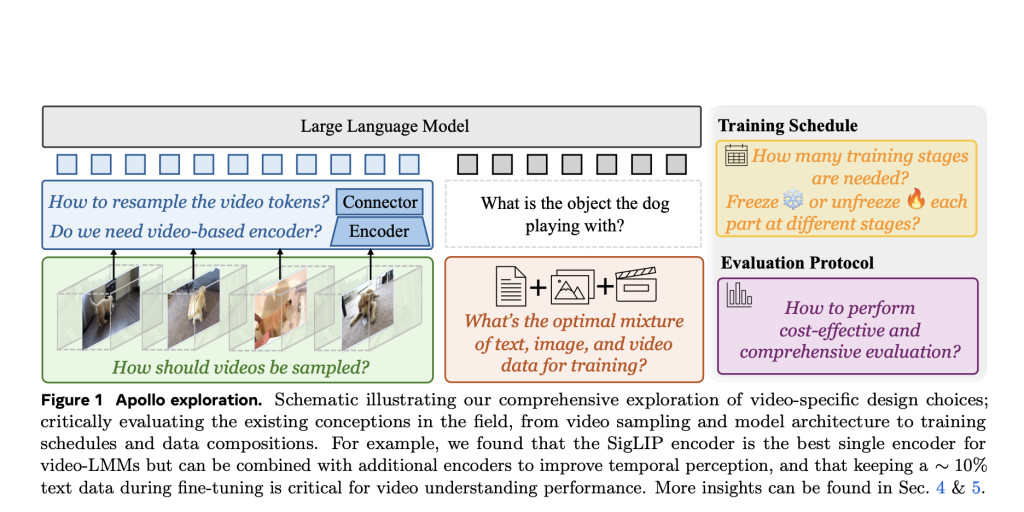

While multimodal models (LMMs) have advanced significantly for text and image tasks, video-based models remain underdeveloped. Videos are inherently complex, combining spatial and temporal dimensions that demand more from computational resources. Existing methods often adapt image-based approaches directly or rely on uniform frame sampling, which poorly captures motion and temporal patterns. Moreover, training large-scale video models is computationally expensive, making it difficult to explore design choices efficiently.
To tackle these issues, researchers from Meta AI and Stanford developed Apollo, a family of video-focused LMMs designed to push the boundaries of video understanding. Apollo addresses these challenges through thoughtful design decisions, improving efficiency, and setting a new benchmark for tasks like temporal reasoning and video-based question answering.
Meta AI Introduces Apollo: A Family of Scalable Video-LMMs

Meta AI’s Apollo models are designed to process videos up to an hour long while achieving strong performance across key video-language tasks. Apollo comes in three sizes – 1.5B, 3B, and 7B parameters – offering flexibility to accommodate various computational constraints and real-world needs.
Key innovations include:
- Scaling Consistency: Design choices made on smaller models are shown to transfer effectively to larger ones, reducing the need for large-scale experiments.
- Frame-Per-Second (fps) Sampling: A more efficient video sampling technique compared to uniform frame sampling, ensuring better temporal consistency.
- Dual Vision Encoders: Combining SigLIP for spatial understanding with InternVideo2 for temporal reasoning enables a balanced representation of video data.
- ApolloBench: A curated benchmark suite that reduces redundancy in evaluation while providing detailed insights into model performance.

Technical Highlights and Advantages
The Apollo models are built on a series of well-researched design choices aimed at overcoming the challenges of video-based LMMs:
- Frame-Per-Second Sampling: Unlike uniform frame sampling, fps sampling maintains a consistent temporal flow, allowing Apollo to better understand motion, speed, and sequence of events in videos.
- Scaling Consistency: Experiments show that model design choices made on moderately sized models (2B-4B parameters) generalize well to larger models. This approach reduces computational costs while maintaining performance gains.
- Dual Vision Encoders: Apollo uses two complementary encoders: SigLIP, which excels at spatial understanding, and InternVideo2, which enhances temporal reasoning. Their combined strengths produce more accurate video representations.
- Token Resampling: By using a Perceiver Resampler, Apollo efficiently reduces video tokens without losing information. This allows the models to process long videos without excessive computational overhead.
- Optimized Training: Apollo employs a three-stage training process where video encoders are initially fine-tuned on video data before integrating with text and image datasets. This staged approach ensures stable and effective learning.
- Multi-Turn Conversations: Apollo models can support interactive, multi-turn conversations grounded in video content, making them ideal for applications like video-based chat systems or content analysis.
Performance Insights
Apollo’s capabilities are validated through strong results on multiple benchmarks, often outperforming larger models:
- Apollo-1.5B:
- Surpasses models like Phi-3.5-Vision (4.2B) and LongVA-7B.
- Scores: 60.8 on Video-MME, 63.3 on MLVU, 57.0 on ApolloBench.
- Apollo-3B:
- Competes with and outperforms many 7B models.
- Scores: 58.4 on Video-MME, 68.7 on MLVU, 62.7 on ApolloBench.
- Achieves 55.1 on LongVideoBench.
- Apollo-7B:
- Matches and even surpasses models with over 30B parameters, such as Oryx-34B and VILA1.5-40B.
- Scores: 61.2 on Video-MME, 70.9 on MLVU, 66.3 on ApolloBench.
Benchmark Summary:

Conclusion
Apollo marks a significant step forward in video-LMM development. By addressing key challenges such as efficient video sampling and model scalability, Apollo provides a practical and powerful solution for understanding video content. Its ability to outperform larger models highlights the importance of well-researched design and training strategies.
The Apollo family offers practical solutions for real-world applications, from video-based question answering to content analysis and interactive systems. Importantly, Meta AI’s introduction of ApolloBench provides a more streamlined and effective benchmark for evaluating video-LMMs, paving the way for future research.
Check out the Paper, Website, Demo, Code, and Models. All credit for this research goes to the researchers of this project. Also, don’t forget to follow us on Twitter and join our Telegram Channel and LinkedIn Group. Don’t Forget to join our 60k+ ML SubReddit.
The post Meta AI Releases Apollo: A New Family of Video-LMMs Large Multimodal Models for Video Understanding appeared first on MarkTechPost.
Source: Read MoreÂ

 Trending: LG AI Research Releases EXAONE 3.5: Three Open-Source Bilingual Frontier AI-level Models Delivering Unmatched Instruction Following and Long Context Understanding for Global Leadership in Generative AI Excellence….
Trending: LG AI Research Releases EXAONE 3.5: Three Open-Source Bilingual Frontier AI-level Models Delivering Unmatched Instruction Following and Long Context Understanding for Global Leadership in Generative AI Excellence….